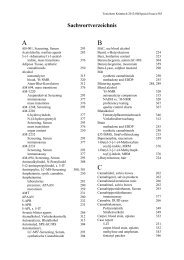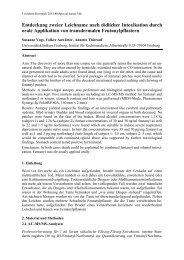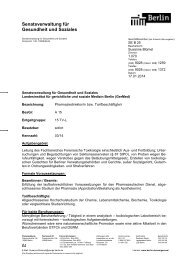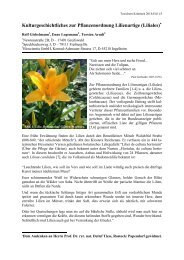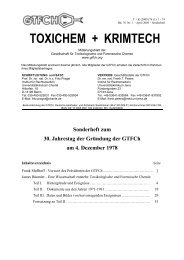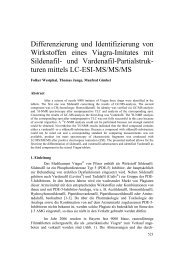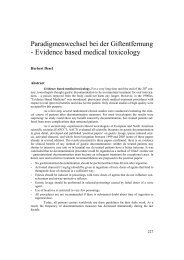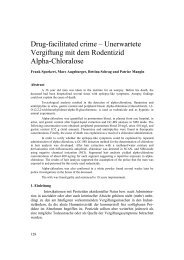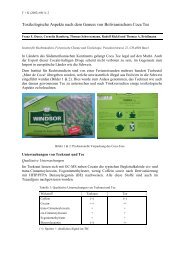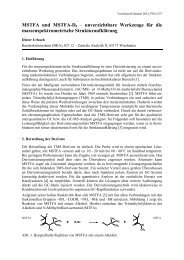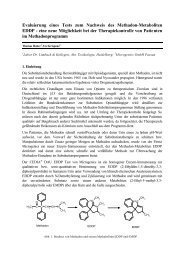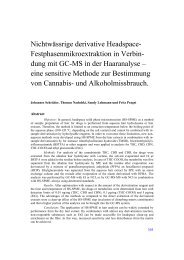Smoke analysis of adulterated illicit drug preparations - GTFCh
Smoke analysis of adulterated illicit drug preparations - GTFCh
Smoke analysis of adulterated illicit drug preparations - GTFCh
You also want an ePaper? Increase the reach of your titles
YUMPU automatically turns print PDFs into web optimized ePapers that Google loves.
Toxichem Krimtech 2011;78(Special Issue):200<br />
<strong>Smoke</strong> <strong>analysis</strong> <strong>of</strong> <strong>adulterated</strong> <strong>illicit</strong> <strong>drug</strong> <strong>preparations</strong><br />
Evelyn Pawlik 1 , Hellmut Mahler 2<br />
1 Universitätsklinikum Düsseldorf, Institut für Rechtsmedizin, Forensische Toxikologie,<br />
Moorenstraße 5, D-40225 Düsseldorf<br />
2 Landeskriminalamt NRW, Kriminalwissenschaftliches und -technisches Institut, D-40221<br />
Düsseldorf, Germany. hellmut.mahler@polizei.nrw.de<br />
Key words: adulterants, effect amplifiers, smoking, marijuana, cocaine, amphetamine<br />
Abstract<br />
Aim: During the last decade the common adulterants for <strong>illicit</strong> <strong>drug</strong> mixtures have changed.<br />
Formerly, sugars and sugar alcohols dominated cutting agents for marijuana, cocaine <strong>preparations</strong><br />
and amphetamines. Nowadays, adulterants in powder <strong>drug</strong>s are predominantly additional<br />
active substances or effect amplifiers (see below). In marijuana samples at the LKA<br />
NRW, sugars and sugar alcohols, food hemp, glass powder, sand, talc, hair spray, nitrate- and<br />
phosphate-containing fertilizers as well as neem oil could be detected in single cases. Elsewhere<br />
lead, synthetic resin, spices and edible oils as well as "Brix" were claimed to be found.<br />
We examined the influence <strong>of</strong> the cutting agents for the preparation <strong>of</strong> crack and freebase and<br />
their pyrolysis properties, in a specially adapted smoking apparatus. Due to reports about<br />
marijuana samples with fertilizers (up to 50 % weight) that cause acute respiratory syndromes,<br />
these materials were likewise tested.<br />
Material and methods: Representative <strong>illicit</strong> <strong>drug</strong> <strong>preparations</strong> from seizures in NRW were<br />
used. Examinations were mainly done by scanning electron microscopy, light microscopy,<br />
X-ray diffraction, ion and gas chromatography as well as HPLC-TOF-MS.<br />
Results and discussion: In the smoke <strong>of</strong> marijuana <strong>adulterated</strong> with fertilizers high fractions <strong>of</strong><br />
nitrogen oxides were found - a possible explanation for respiratory effects.<br />
Amphetamine sulphate salts <strong>adulterated</strong> with caffeine and 4-fluoroamphetamine were<br />
checked for smoking. Merely caffeine and 4-fluoroamphetamine were detected in relevant<br />
amounts. Cocaine <strong>preparations</strong> <strong>adulterated</strong> with lidocaine, procaine, diltiazem, hydroxyzine,<br />
levamisol, caffeine and phenacetin were converted to crack and freebase samples, analyzed<br />
and then smoked in suitable apparatus. The smoke gases were condensed and analyzed. The<br />
production <strong>of</strong> freebase and crack may eliminate sugar and sugar alcohols, but all other cutting<br />
substances were present in the cocaine base <strong>preparations</strong>. In the smoke these cutting substances<br />
were detected in similar fractions. Phenacetin, lidocaine, procaine and diltiazem<br />
showed the best recovery. Toxicological effects for the lung are discussed.<br />
Conclusion: The examined adulterants in amphetamine or cocaine <strong>preparations</strong>, caffeine,<br />
4-fluoroamphetamine, phenacetin, hydroxyzine, diltiazem, lidocaine and procaine as well as<br />
fertilizers (on marijuana samples) can be inhaled via smoking, since they were found in the<br />
smoke condensates in sufficient amounts.<br />
1. Introduction<br />
The abuse <strong>of</strong> <strong>drug</strong>s like cocaine, amphetamine and marijuana causes various toxic effects predominantly<br />
on the cardiovascular-system [1] and the brain (e.g. cerebral infarct). But not only<br />
the <strong>drug</strong>s themselves are carrier <strong>of</strong> serious risk for the health, just as the adulterants within the<br />
illegally traded <strong>drug</strong> <strong>preparations</strong>. During the last decade cutting agents typically used for<br />
<strong>illicit</strong> <strong>drug</strong> mixtures have changed. In the past, sugar and sugar alcohols were predominantly
Toxichem Krimtech 2011;78(Special Issue):201<br />
used for the cutting <strong>of</strong> amphetamine, cocaine and marijuana. Today powder <strong>drug</strong>s like<br />
cocaine and amphetamine were <strong>adulterated</strong> with active substances or effect amplifiers like the<br />
local anesthetics lidocaine, procaine, benzocaine and tetracaine, the psychoactive stimulantes<br />
caffeine, phenacetin and 4-fluoroamphetamine, the anthelminthic levamisole, the antihistamine<br />
hydroxyzine, and the calcium channel blocker diltiazem, as well as various other<br />
substances. In addition to the above mentioned cutting agents for hemp products, some marijuana<br />
samples examined by the LKA NRW contained glass powder, food hemp, sand, talc,<br />
hair spray, nitrate- and phosphate-containing fertilizers as well as neem oil. Elsewhere lead<br />
[2] was detected and synthetic resin, spices and edible oils as well as a product named "Brix"<br />
(the internet reference describes it as synthetic liquid with e. g. sugar and “liquid polymer”,<br />
that shall be prepared “especially for the adulteration <strong>of</strong> marijuana”) were claimed to be<br />
found [3] i . However products with the name “Brix” (described to contain carbohydrates,<br />
amino acids and vitamins) are sold as plant boosters, that are claimed to transport nutritive<br />
either by soil or directly via the leaf into the plants. Leaf fertilisation is a method that may<br />
work for water soluble compounds e. g. inorganic salts and in limited manner for small organic<br />
molecules like sugars. Maybe the use <strong>of</strong> “Brix” 7 to 10 days prior harvest is due to a<br />
misunderstanding or a wrong handling <strong>of</strong> plant growth products and the finding <strong>of</strong> “liquid<br />
polymer” due to a presence <strong>of</strong> starch.<br />
Adulterants or cutting agents are mainly used to increase the weight to develop sales. Sometimes<br />
impurities accidentally attain a product e.g. during a bad done synthesis or they even<br />
might be added deliberately. Therefore, cocaine consumers claim to reach a cleansing effect<br />
by transforming their cocaine hydrochloride <strong>preparations</strong> into the freebase for smoking, which<br />
is more effective to a so called “flash”. Thus, the examination <strong>of</strong> cleansing effects <strong>of</strong> cocaine<br />
hydrochloride <strong>preparations</strong> by the transformation to freebase and crack cocaine was carried<br />
out. In addition, cocaine and amphetamine <strong>preparations</strong> as well as <strong>adulterated</strong> marijuana were<br />
smoked in a specially adapted smoke apparatus, which should simulate the smoke behaviour<br />
<strong>of</strong> a consumer. The apparatus was validated for this purpose with non-<strong>adulterated</strong> marijuana<br />
previously. The aim <strong>of</strong> the present study was the <strong>analysis</strong> <strong>of</strong> substances (cutting agents) which<br />
passed over into the smoke as well as the detection <strong>of</strong> pyrolysis properties <strong>of</strong> the smoked<br />
<strong>preparations</strong>.<br />
2. Materials and Methods<br />
2.1. Materials<br />
2.1.1. Construction <strong>of</strong> the smoke apparatus<br />
!<br />
Fig. 1. Construction <strong>of</strong> the smoke apparatus used<br />
for the smoke attempts consisting <strong>of</strong> a glass frit<br />
column (NS 14.5), a silicon sealed thermometer<br />
adaptor (NS 14.5), a vacuum thrust (NS 14.5), a<br />
250 ml three-neck round-bottom flask with a<br />
Vigreux column (NS 14.5) [or alternatively with a<br />
Liebig condenser (NS 14.5)], a two-neck adaptor<br />
(NS 14.5), two adaptor with olive, a 500 ml<br />
washing bottle and a water jet pump with a<br />
vacuum measurement display. For the respective<br />
question the apparatus was checked and changed<br />
if necessary to achieve optimum results.!
Toxichem Krimtech 2011;78(Special Issue):202<br />
2.1.2. Chemicals and reagents<br />
Marijuana samples from seizures in the <strong>illicit</strong> <strong>drug</strong> market [sample no.: a) 100; b) 110; c)<br />
150]; tobacco (Natural American Spirit); Rotisol ! 99 %; tribenzylamine (TBA) > 99 %;<br />
nitrogen 5.0; argon; liquid nitrogen; amphetamine sulphate (a) Merck; b) sample no.: 200; c)<br />
sample no.: 210); C 20 H 42 (icosane) ! 98 %; sodium lye 2M; methyl tert-butyl ether 99,5 %;<br />
pyridine ! 99 %, p.a.; MBTFA; Cocaine samples from seizure <strong>of</strong> the <strong>illicit</strong> <strong>drug</strong> market [a)<br />
sample no.: 300; b) sample no.: 310; c) sample no.: 350; d) sample no.: 380]; 10% ammonia<br />
solution; C 24 H 50 (tetracosane) ! 99 %; CHCl 3 ! 99 %, p.a.; MSHFBA; potassium dihydrogen<br />
phosphate (anhydrous); ammonium formate (> 97 %); nitrite ion chromatography standard<br />
(1000 g/L); multi elements ion chromatography anion standard solution (fluoride: 3 mg/kg,<br />
chloride: 10 mg/kg, bromide: 20 mg/kg, nitrate: 20 mg/kg, sulphate: 20 mg/kg, phosphate: 30<br />
mg/kg); sodium chlorate (! 98 %).<br />
2.2. Methods<br />
2.2.1. Analyses <strong>of</strong> non-smoked and smoked amphetamine sulphate, freebase cocaine and<br />
crack samples<br />
Preliminary remarks: Weighing <strong>of</strong> smoking condensates (substances which passes over into<br />
the smoke or precipitated on the glass vessels) was not possible, therefore the relative ratios <strong>of</strong><br />
the peak areas (GC-PND) <strong>of</strong> the source <strong>preparations</strong> (marijuana, amphetamine and cocaine<br />
<strong>preparations</strong>) were compared with those <strong>of</strong> the preserved smoke condensates (shown in the<br />
tables below). The determined relative peak ratios <strong>of</strong> the amphetamine <strong>preparations</strong> were<br />
always corresponded to the amphetamine base, relative peak ratios <strong>of</strong> the cocaine <strong>preparations</strong><br />
to cocaine hydrochloride and the relative peak ratios <strong>of</strong> marijuana based on the previously<br />
achieved amounts <strong>of</strong> THC.<br />
2.2.1.1. Validation <strong>of</strong> the smoke apparatus for the suitability in smoking marijuana<br />
400 mg marijuana were crushed and transferred into a glass frit column (Fig. 1.) and slightly<br />
pressed onto the ground <strong>of</strong> the frit with a cotton bud. A vacuum <strong>of</strong> 940 mbar (pump pressure<br />
with closed apparatus) and/or 970 mbar (with slightly open apparatus) was adjusted by the use<br />
<strong>of</strong> the water jet pump. The sample was inflamed with a wooden stick. Smoking procedure was<br />
regulated by adjusting the vacuum with the three-way valve - three seconds <strong>of</strong> ventilation <strong>of</strong><br />
the smoking apparatus simulated the exhalation, while five seconds <strong>of</strong> vacuum simulated the<br />
inhalation. Cooling <strong>of</strong> the three-neck round-bottom flask with water or alternatively with ice<br />
water was necessary to retain most <strong>of</strong> the active substances, which passed over into the<br />
smoke. For the gas <strong>analysis</strong> samples, liquid nitrogen was used as cooling agent. After the entire<br />
combustion <strong>of</strong> the applied material the smoking apparatus was left for some minutes to<br />
assure the condensing <strong>of</strong> the smoke completely inside the apparatus. The smoke condensate<br />
was transferred into 10 ml roll edge snap bottles or 50 ml Erlenmeyer flask by rinsing the<br />
glass vessels with ethanol for several times. Therefore four kind <strong>of</strong> samples were taken, to<br />
check the cooling effects <strong>of</strong> the round-bottom flask: a) outlet <strong>of</strong> the glass frit column with<br />
thermometer adaptor; b) vacuum piping with the 250 ml three-neck round-bottom flask; c)<br />
Vigreux column or Liebig condenser; d) two-neck adaptor and adapter with olive and if<br />
necessary, a test from the washing bottle (e). The ethanol solved smoke condensates were put<br />
on a 50°C hot plate (according to the smoked material) and ventilated with nitrogen until dryness.<br />
As reference non <strong>adulterated</strong> material tobacco ("Natural American Spirit") was smoked<br />
in a similar way. Smoking procedures were carried out 2-3 times (<strong>adulterated</strong> marijuana,<br />
amphetamine, cocaine).
Toxichem Krimtech 2011;78(Special Issue):203<br />
2.2.1.2. Preparation <strong>of</strong> freebase cocaine according to a lab-internal protocol<br />
3 g <strong>of</strong> a cocaine hydrochloride preparation were solved in 30 ml tepid water in a 50 ml<br />
Erlenmeyer flask. The mixture was treated with an ammonia solution (10%, v/v) until precipitation<br />
was finished. The pH <strong>of</strong> the solution was checked with indicator paper (pH should<br />
be > 9). The freebase cocaine was separated via extraction with methyl tert-butyl ether in a<br />
separatory funnel and afterwards dried under a stream <strong>of</strong> nitrogen at 50°C for approx. 1 h.<br />
The yield was determined by weight.<br />
2.2.1.3. Preparation <strong>of</strong> crack cocaine according to a lab-internal protocol<br />
3 g <strong>of</strong> a cocaine hydrochloride preparation and 1.5 g sodium hydrogen carbonate were dissolved<br />
in 30 ml water in a 50 ml Erlenmeyer flask. The solution was boiled on a hot plate<br />
until no more precipitation occurred (approx. 5 ml <strong>of</strong> the solution remained in the flask).<br />
Afterwards, the precipitate was filtered and washed with 5 ml ice water for several times. The<br />
product was dried for 4 h at 50°C and the yield was determined by weight.<br />
2.2.1.4. Smoking procedure <strong>of</strong> amphetamine sulphate/-<strong>preparations</strong> in the smoke apparatus<br />
Amphetamine sulphate or amphetamine sulphate <strong>preparations</strong> were smoked similar as described<br />
for freebase cocaine and crack. Therefore 50 mg or 150 mg <strong>of</strong> amphetamine sulphate<br />
or the preparation (according to potency <strong>of</strong> the sample) were mixed with the tobacco <strong>of</strong> one<br />
cigarette (“Natural American Spirit") and smoked. According to the results <strong>of</strong> the validation<br />
only two kind <strong>of</strong> samples were taken <strong>of</strong> the smoke apparatus: a) outlet <strong>of</strong> the glass frit column<br />
with thermometer adaptor and b) remaining part <strong>of</strong> the smoke apparatus.<br />
2.2.1.5. Smoking procedure <strong>of</strong> 4-fluoroamphetamine-base<br />
50 µl 4-fluoroamphetamine-base were dropped on the tobacco <strong>of</strong> one cigarette “Natural<br />
American Spirit” and smoked in the smoke apparatus as described for freebase cocaine and<br />
crack. Quantification was carried out like in detail described under 2.2.1.8.<br />
2.2.1.6. Smoking <strong>of</strong> freebase and crack cocaine in the smoke apparatus<br />
50-150 mg freebase cocaine or crack <strong>preparations</strong> were smoked under a constantly reduced<br />
pressure by means <strong>of</strong> a Bunsen burner in the smoke apparatus. Only one sample was taken for<br />
the <strong>analysis</strong> (complete smoke apparatus).<br />
2.2.1.7. Quantification <strong>of</strong> THC in <strong>adulterated</strong> and non-<strong>adulterated</strong> marijuana samples and the<br />
smoke condensates<br />
10 mg tribenzylamine (TBA; ISTD) and 10 ml ethanol (95:5, v/v; ethanol/acetone) were<br />
mixed with the dry marijuana smoke condensate or 200 mg <strong>of</strong> the marijuana sample. The<br />
mixture was solved in an ultrasonic bath for 15 min. 1 ml <strong>of</strong> this solution was filled into a<br />
GC-vial and measured by GC-FID (1 µl).<br />
2.2.1.8. Quantification <strong>of</strong> amphetamine in <strong>adulterated</strong> and non-<strong>adulterated</strong> amphetamine<br />
sulphate <strong>preparations</strong> and smoke condensates<br />
100 mg amphetamine or the whole dry amphetamine smoke condensate and 50 mg <strong>of</strong> C 20 H 42<br />
(ISTD) were mixed with 10 ml sodium lye (2M) and 40 ml methyl tert-butyl ether in an<br />
Erlenmeyer flask. The two phases were incubated for 15 min in an ultrasonic bath. 1 ml <strong>of</strong> the<br />
ether phase was pipetted into a GC-vial and mixed with 100 µl pyridine and 300 µl <strong>of</strong> N-<br />
methyl-bis(trifluoroacetamide) (MBTFA). The vial was closed, mixed by mild shaking and<br />
examined with GC-FID (1 µl).
Toxichem Krimtech 2011;78(Special Issue):204<br />
2.2.1.9. Quantification <strong>of</strong> cocaine in <strong>adulterated</strong> freebase and crack cocaine <strong>preparations</strong> and<br />
smoke condensates<br />
25 mg <strong>of</strong> a cocaine preparation or the whole dry smoke condensate and 10 mg C 24 H 50 (ISTD)<br />
were mixed with 8 ml chlor<strong>of</strong>orm. The mixture was treated in an ultrasonic bath for 15 min.<br />
750 µl <strong>of</strong> the solution were filled in a GC-vial and mixed with 100 µl pyridine and 250 µl N-<br />
methyl-N-trimethylsilyl-heptafluorobutyramide (MSHFBA). The mixture was incubated for<br />
10 min at 80°C in a heat bath and measured by GC-FID (1 µl).<br />
2.2.1.10. Analyses and quantification <strong>of</strong> the adulterants<br />
Analyses were carried out using GC-FID, GC-PND as well as GC-MS. Some additional<br />
analyses were carried out by the use <strong>of</strong> HPLC-TOF-MS.<br />
GC-FID: Adulterants were quantified by single-point calibration. Sample preparation (freebase<br />
and crack cocaine, amphetamine) was carried out as described above. Adulterants were<br />
quantified in the freebase and crack <strong>preparations</strong> as well as in the amphetamine <strong>preparations</strong>.<br />
GC-MS: The dry smoke condensates <strong>of</strong> the <strong>adulterated</strong> amphetamine and cocaine <strong>preparations</strong><br />
were mixed with 1 ml <strong>of</strong> a pyridine:chlor<strong>of</strong>orm solution (2:8, v/v) and derivatized with<br />
MBTFA (amphetamine) or MSHFBA (cocaine). The cocaine samples were placed into a<br />
heating/thermal bath for 30 min at 80°C. 1 µl <strong>of</strong> the samples were analysed by GC-MS.<br />
GC-PND: 2 mg <strong>of</strong> the freebase and crack cocaine <strong>preparations</strong>, the amphetamine <strong>preparations</strong><br />
as well as the dry smoke condensates were mixed with 1 ml ethanol and analysed by GC-FID.<br />
HPLC-TOF-MS: Dry smoke condensates <strong>of</strong> the <strong>adulterated</strong> amphetamine and cocaine <strong>preparations</strong><br />
were dissolved in water/acetonitrile (50:50, v/v) and analysed by HPLC-TOF-MS.<br />
2.2.2. Analyses <strong>of</strong> <strong>adulterated</strong> marijuana<br />
Analyses <strong>of</strong> the <strong>adulterated</strong> marijuana sample were carried out via scanning electron microscopy,<br />
light microscopy, X-ray diffraction, ion and gas chromatography and HPLC-TOF-MS.<br />
2.2.2.1. Quantification <strong>of</strong> anions via ion chromatography<br />
As a standard for the ion chromatography, 1 ml <strong>of</strong> the multi elements ion chromatography<br />
solution was mixed with 100 µl <strong>of</strong> a nitrite standard solution (g/ml) and 100 µl <strong>of</strong> an acetate<br />
standard solution (g/ml) in 100 ml distilled water.<br />
Analyses <strong>of</strong> anions were carried out in 10 ml solutions.<br />
a) Rinsing <strong>of</strong> the marijuana <strong>adulterated</strong> with fertilizer<br />
b) <strong>Smoke</strong> condensate <strong>of</strong> the <strong>adulterated</strong> marijuana<br />
c) Non <strong>adulterated</strong> marijuana as reference (sample no.: 100)<br />
Solutions were filtered before each measurement.<br />
2.2.3. Instrumentation<br />
GC-FID: Agilent 6890 GC coupled with a FID. Column HP-1 ultra 25 m, 0.32 mm i.d., 0.17<br />
µm df, carrier gas Nitrogen, injector 300°C<br />
THC: 1.0 ml/min, oven: init 210°C, 3.0 min, rate 6°C/min, to 300°C for 3 min, run time 21<br />
min, split 50:1<br />
Amphetamine: 1.1 ml/min, oven: init 120°C, 3 min, rate 10°C/min, to 300°C for 3 min, run<br />
time 21 min, split 50:1<br />
Cocaine: 1.0 ml/min, oven: init 210°C, 3 min, rate 6°C/min, to 300°C for 0 min, run time 18<br />
min, split 50:1
Toxichem Krimtech 2011;78(Special Issue):205<br />
HPLC-TOF-MS: Agilent system LC 1200 Series coupled with Bruker MS microTOF-Q II.<br />
Column YMC-Pack ODS-AQ 150 mm, 2 mm i.d., 3 µm df, eluent 30% acetonitrile/70%<br />
water containing 0.05% formic acid, 0.2 ml/min, ESI 4500 V (50-1000 amu) SCAN mode<br />
GC-PND: Agilent 6890 coupled with a PND. Column HP-1 ultra 25 m, 0.32 mm i.d., 0.17 µm<br />
df, carrier gas Nitrogen, injector 300°C, 1.2 ml/min, oven: init 100°C, 2 min, rate 10°C/min,<br />
to 300°C for 6 min, run time 28 min, split 40:1<br />
GC-MS: Agilent 6890 coupled with a MSD 5973. Column HP-5MS 5% Methyl Siloxane 30<br />
m, 250 µm i.d., 0,25 µm df, carrier gas Helium (5.0), 1.0 ml/min, injector 250°C, oven: init<br />
70°C, 2.0 min, rate 20°C/min, to 300°C for 20 or 23 min, run time 35.50 or 36.50 min, split<br />
50:1, EI mode 70 eV, SCAN 40-600<br />
Ion chromatography: 861 Advanced Compact Metrohm. Column Metrosep A supp 4 250 mm,<br />
4 mm i.d, eluent a solution <strong>of</strong> 1.9 mmol/l sodium carbonate, 1.0 mmol/l sodium hydrogen<br />
carbonate and 5 % acetonitrile, temperature 20°C, 1 ml/min<br />
3. Results and Discussion<br />
3.1. Analyses <strong>of</strong> <strong>adulterated</strong> amphetamine sulphate <strong>preparations</strong><br />
It is well known that amphetamine sulphate could not be smoked, since it pyrolysed at the<br />
occurred temperatures during the smoking procedure. In form <strong>of</strong> the base, amphetamine however,<br />
passes over into to the smoke in sufficient amounts and could be easily taken up by the<br />
lung <strong>of</strong> a consumer. But this would affect the respiratory pathways belonging to the strong<br />
basicity <strong>of</strong> the amphetamine base. Therefore it was not converted to its free base, and the aim<br />
<strong>of</strong> the present study was to examine, whether amphetamine sulphate as well as adulterants<br />
contained in amphetamine sulphate <strong>preparations</strong> could be smoked. Besides 4-fluoroamphetamine<br />
was tested, since it is <strong>of</strong>ten used as an adulterant in amphetamine sulphate <strong>preparations</strong>.<br />
In addition to sugars the most common adulterant is caffeine.<br />
The potencies <strong>of</strong> amphetamine sulphate and amphetamine sulphate <strong>preparations</strong> were measured<br />
before (amphetamine sulphate 74.7 %; sample no.: 210 10.3 %; sample no.: 200 3.56 %)<br />
and after the smoking procedure (0.51 – 18.44 %) via GC-FID. In some <strong>of</strong> the smoke condensates<br />
amphetamine could not be detected (sample no.: 200). Therefore more analyses were<br />
carried out via GC-PND, GC-MS and HPLC-TOF-MS, to confirm that amphetamine (at low<br />
concentrations), but also caffeine and 4-fluoroamphetamine could be smoked and therefore<br />
reached the body <strong>of</strong> the consumer. Amphetamine, as well as caffeine and 4-fluoroamphetamine<br />
could be detected via the mentioned methods.<br />
Quantification <strong>of</strong> smoke condensates, which may contain 4-fluoroamphetamine, resulted in a<br />
potency <strong>of</strong> 0.046 %, corresponded to 0.069 mg active substance after the smoking <strong>of</strong> 150 mg<br />
<strong>of</strong> an amphetamine sulphate preparation. As reference material pure 4-fluoroamphetamine<br />
(100 %; 52.1 mg) was smoked. 0.82-3.51 mg 4-fluoroamphetamine could be detected in the<br />
smoke condensates via GC-FID. Since only few information on 4-fluoroamphetamine exists,<br />
toxic effects and the damage potential <strong>of</strong> this substance for the lung remain uncertain. However,<br />
it could be supposed that 4-fluoroamphetamine may cause similar effects as amphetamine<br />
and MDMA. Reliable data on the toxic effects <strong>of</strong> 4-fluoroamphetamine are not available.<br />
Also it is not known in which way amphetamine would be smoked by consumers, like it<br />
is known for cocaine. In the present study, the amphetamine sulphate or the corresponding<br />
<strong>preparations</strong> were smoked after admixture <strong>of</strong> tobacco. Other smoking procedures <strong>of</strong> amphetamine<br />
are possible, since recently amphetamine was found in some cocaine <strong>preparations</strong>.<br />
Quantifications <strong>of</strong> the adulterants in such amphetamine sulphate <strong>preparations</strong> were carried out<br />
by calculating the relative ratios <strong>of</strong> the peak areas. Therefore, the measured GC-PND peak<br />
areas <strong>of</strong> the source <strong>preparations</strong> were compared with those <strong>of</strong> the condensates (Tab. 1).
Toxichem Krimtech 2011;78(Special Issue):206<br />
Tab. 1. Overview <strong>of</strong> the <strong>adulterated</strong> amphetamine <strong>preparations</strong> and the percentile amount <strong>of</strong> the adulterants in<br />
the smoke condensates.<br />
No.<br />
Drug<br />
potency<br />
(GC-FID)<br />
[%]<br />
200 3.56<br />
Adulterant<br />
potency<br />
(GC-FID)<br />
[%]<br />
Adulterant<br />
Peak area<br />
<strong>drug</strong><br />
source<br />
preparation<br />
(GC-PND)<br />
Peak area<br />
adulterant<br />
source<br />
preparation<br />
(GC-PND)<br />
34.38 Caffeine 2016<br />
3.92 4-FA<br />
12.63<br />
Amphetamine<br />
8.13<br />
210 10.3 30.55 Caffeine 45.67 1910<br />
Peak area<br />
smoke<br />
condensate<br />
<strong>drug</strong><br />
Peak area<br />
smoke<br />
condensate<br />
adulterant<br />
Rel. ratio <strong>of</strong> the<br />
peak areas<br />
<strong>drug</strong>/adulterant<br />
not smoked<br />
(GC-PND) [%]<br />
Rel. ratio <strong>of</strong> the<br />
peak areas<br />
<strong>drug</strong>/adulterant<br />
in the smoke<br />
(GC-PND) [%]<br />
84.99 8959 99.1<br />
99.4<br />
55.24 6447<br />
99.2<br />
84.99 67.04 44.1<br />
39.2<br />
55.24 46.17<br />
45.5<br />
6.59 234.72 97.2<br />
97.6<br />
31.62 253.44<br />
88.9<br />
The results demonstrated, that it is possible to smoke amphetamine sulphate as well as<br />
caffeine and 4-fluoroamphetamine. Besides it shown, that the relative ratios <strong>of</strong> the peak areas<br />
in the source <strong>preparations</strong> are nearly the same as in the related smoke condensates. Therefore,<br />
it could be figured out that not only the <strong>drug</strong> itself reaches the lung <strong>of</strong> the consumer, but also<br />
the adulterants within the <strong>drug</strong> <strong>preparations</strong>. Interactions between the mentioned adulterants<br />
and the smoked <strong>drug</strong> cannot be excluded. According to laboratory experience, 1 g <strong>of</strong> an average<br />
amphetamine sulphate preparation is <strong>adulterated</strong> with about 0,7 g caffeine, which correspond<br />
to a consumption <strong>of</strong> 7 cups c<strong>of</strong>fee in a typical single dose <strong>of</strong> amphetamine (50 mg).<br />
Hence, increasing <strong>of</strong> the dependency potential due to compounds related to ephedrine is possible.<br />
Withdrawal symptoms like headaches, daze, tiredness, interferences <strong>of</strong> intellectual and<br />
motor abilities and concentration deficit [4] resulted <strong>of</strong> discontinue after caffeine consumption<br />
after longer expositions.<br />
3.2. Analyses <strong>of</strong> <strong>adulterated</strong> freebase and crack cocaine <strong>preparations</strong><br />
Analogue to amphetamine sulphate, cocaine hydrochloride could not be smoked, since it<br />
pyrolysed during the smoking procedure. Therefore, cocaine <strong>preparations</strong> <strong>adulterated</strong> with<br />
lidocaine, procaine, diltiazem, hydroxyzine, levamisole, caffeine and phenacetin, were converted<br />
to freebase as well as crack cocaine samples, analyzed and then smoked in a suitable<br />
apparatus. The smoke was condensed and analyzed. As expected, smoking procedure could<br />
not be adapted precisely to the smoke behaviour <strong>of</strong> a consumer, while different smoke conditions<br />
resulted in different relative peak area ratios (<strong>drug</strong>/adulterant) (Tab. 2). Besides, results<br />
were also not reproducible. Cocaine could still be detected in all smoke condensates. The<br />
active substance amounts <strong>of</strong> the condensates differ between 1.4 mg (minimum) to 33.9 mg<br />
cocaine (maximum) in relation to 100 mg smoked freebase cocaine preparation, with active<br />
substance abundance <strong>of</strong> 55.6 – 67.5 mg cocaine. The active substance amount <strong>of</strong> the smoked<br />
crack <strong>preparations</strong> differ between 1.0 mg and 27.7 mg in relation to 150 mg or 50 mg <strong>of</strong> the<br />
preparation, with a active substance amount <strong>of</strong> 36.2 mg or 50.4 mg.<br />
The preparation <strong>of</strong> freebase and crack cocaine may eliminate sugar and sugar alcohols, but all<br />
other examined adulterants were presented in the cocaine samples. <strong>Smoke</strong> analyses with<br />
GC-PND, GC-MS and HPLC-TOF-MS show that adulterants were detected in similar ratios.<br />
Phenacetin, lidocaine, procaine and diltiazem showed the best recovery. Even levamisole<br />
could be found, but was not quantified as well as procaine. Toxic effects <strong>of</strong> the detected<br />
adulterants on the lung are unclear and topic <strong>of</strong> further research. Beside the mentioned adulterants,<br />
the list <strong>of</strong> other cutting agents is long. More and even new compounds are expected as<br />
adulterants <strong>of</strong> <strong>illicit</strong> <strong>drug</strong>s. Because most examinations in the State Bureau <strong>of</strong> Criminal
Toxichem Krimtech 2011;78(Special Issue):207<br />
Investigation were done on huge seizures, it can be assumed that <strong>drug</strong> <strong>preparations</strong> consumed<br />
by the end users are by far more <strong>adulterated</strong>. The percentile amounts (%) <strong>of</strong> the adulterants<br />
were calculated analogue to the amphetamine <strong>preparations</strong> (Tab. 2).<br />
Tab. 2. Overview <strong>of</strong> the <strong>adulterated</strong> freebase and crack cocaine <strong>preparations</strong> and the percentile amount <strong>of</strong> the<br />
adulterants in the smoke condensates.<br />
No.<br />
Drug<br />
potency [%]<br />
(GC-FID)<br />
300 67.5<br />
380 42.9<br />
310 55.6<br />
Adulterant<br />
potency [%]<br />
(GC-FID)<br />
Adulterant<br />
Peak area<br />
<strong>drug</strong> source<br />
preparation<br />
(GC-PND)<br />
Peak area<br />
adulterant<br />
source<br />
preparation<br />
(GC-PND)<br />
Freebase cocaine<br />
28.48 Phenacetin 744<br />
6.63 Lidocaine<br />
2449<br />
602<br />
4.91 Diltiazem 270<br />
53.92 Phenacetin<br />
1360<br />
1424<br />
0.21 Caffeine 37<br />
3.07 Diltiazem 159<br />
2.46 Hydroxyzine 106<br />
39.79 Phenacetin<br />
2020<br />
1042<br />
Peak area<br />
smoke<br />
condensate<br />
<strong>drug</strong><br />
(GC-PND)<br />
Peak area<br />
smoke<br />
condensate<br />
adulterant<br />
(GC-PND)<br />
Rel. ratio <strong>of</strong><br />
the peak areas<br />
<strong>drug</strong>/adulterant<br />
not smoked<br />
(GC-PND) [%]<br />
Rel. ratio <strong>of</strong> the<br />
peak areas<br />
<strong>drug</strong>/adulterant<br />
in the smoke<br />
(GC-PND) [%]<br />
3012.0 1993.0 23.3 39.8<br />
189.3 509.8 23.3 72.9<br />
652.2 1051.8 23.3 61.7<br />
352.7 2175.9 23.3 86.1<br />
532.0 2703.6 23.3 83.6<br />
3012.0 1526.8 19.7 33.6<br />
189.3 464.6 19.7 71.1<br />
652.2 768.3 19.7 54.1<br />
352.7 1861.1 19.7 84.1<br />
532.0 2218.4 19.7 80.7<br />
644.6 382.3 16.6 37.2<br />
1368.3 426.4 16.6 23.8<br />
644.6 7804.6 16.6 92.4<br />
1368.3 9113.5 16.6 86.9<br />
13655.5 402.6 1.8 2.9<br />
12681.9 368.9 1.8 2.8<br />
13655.5 662.2 7.3 4.6<br />
12681.9 649.0 7.3 4.9<br />
13655.5 283.3 5.0 2.0<br />
12681.9 424.5 5.0 3.2<br />
13655.5 9211.4 34.0 40.3<br />
12681.9 6234.5 34.0 33.0<br />
350 80 / Procaine / / / / / /<br />
310 24.1<br />
Crack cocaine<br />
0.6 Caffeine 108<br />
68.49 Phenacetin 1850<br />
1.48 Hydroxyzine 57<br />
1.25 Diltiazem<br />
755<br />
84<br />
241.8 916.2 12,5 79.1<br />
1463.8 656.5 12,5 31.0<br />
241.8 4985.9 71,0 95.4<br />
1463.8 4671.8 71,0 76.1<br />
241.8 52.5 7,0 17.8<br />
1463.8 104.6 7,0 6.7<br />
241.8 128.1 10,0 34.6<br />
1463.8 218.6 10,0 13.0<br />
350 100.7 / Procaine / / / / / /<br />
The results demonstrated, that each examined adulterant can be smoked and reaches the lung<br />
in higher amounts than the <strong>drug</strong> itself (e.g. phenacetin is found in 20 fold amount to cocaine).<br />
This indicates that the consumer seems to be more affected by the adulterants than by the <strong>drug</strong><br />
itself. Procaine was not quantified, but analyses with the GC-PND show that it also can be
Toxichem Krimtech 2011;78(Special Issue):208<br />
smoked. Lactose or other sugars could not be detected, demonstrating that it could not be<br />
smoked or was eliminated before.<br />
3.3. Analyses <strong>of</strong> <strong>adulterated</strong> marijuana<br />
Adulterated marijuana (potency 8.05 %) was analyzed via light (Fig. 2) and scanning electron<br />
microscope (Fig. 3).<br />
Fig. 2. Dried marijuana sample. Left: the whole marijuana blossom with some white crystals<br />
on it. Right: trichomes <strong>of</strong> the marijuana blossoms with white crystals.<br />
Therefore, the crystalline white solid on top <strong>of</strong> the sample as well as a rinsing <strong>of</strong> the solid was<br />
examined. The elemental <strong>analysis</strong> showed that the main part <strong>of</strong> the crystalline solid consists<br />
<strong>of</strong> the elements phosphorus and potassium (Fig. 3).<br />
!<br />
! !<br />
!<br />
Fig. 3. Analyses via scanning electron microscopy <strong>of</strong> the white solid <strong>of</strong> the marijuana (above)<br />
and rinsing <strong>of</strong> the solid (bottom).
Toxichem Krimtech 2011;78(Special Issue):209<br />
Further investigations were carried out by wet chemical <strong>analysis</strong> and ion chromatography.<br />
The analyses confirm the evidence <strong>of</strong> phosphorus. Furthermore, the presence <strong>of</strong> nitrate,<br />
fluoride, chloride and sulphate was confirmed. These results indicated that the marijuana must<br />
have been treated with a potassium-phosphate/-nitrate fertilizer in the time between breeding<br />
and sale. Quantifications were carried out via anion chromatography. Thus 160 mg marijuana<br />
contained <strong>of</strong> 14.93 mg phosphate, 8.80 mg nitrate and low amounts <strong>of</strong> fluoride, chloride and<br />
sulphate. Therefore, it could be assumed that the marijuana sample (593 g) was <strong>adulterated</strong><br />
with 55.33 g phosphate, 32.62 g nitrate and 8.11 g fluoride-, chloride- and sulphate. The<br />
amount <strong>of</strong> the counter ion potassium for nitrate, phosphate and the other ions, was estimated.<br />
Belonging to the approval, that for each phosphate ion one potassium ion had to be established<br />
to form potassium dihydrogen phosphate, an overall amount <strong>of</strong> 22.78 g potassium were<br />
present. For nitrate 20.57 g and for the other ions 14.66 g <strong>of</strong> potassium were calculated, resulting<br />
in about 27 % fertilizers on the marijuana. In the smoke condensates <strong>of</strong> the <strong>adulterated</strong><br />
marijuana lower amounts <strong>of</strong> the mentioned ions could be detected. Besides, formate or acetate<br />
as well as nitrite could be found (Fig. 4).<br />
Fig. 4. Ion chromatogram <strong>of</strong> a marijuana smoke condensate.<br />
Additional analyses <strong>of</strong> the smoke via Headspace-GC-MS-SPME show also the presence <strong>of</strong><br />
nitrogen oxide, which seems to be a possible explanation for respiratory effects described by<br />
some consumers. Moreover, the adverse effects <strong>of</strong> nitrite and/or nitrogen oxide last from<br />
headaches to acute symptoms like methemoglobinemia and hypotension [5].<br />
For the final assessment <strong>of</strong> the white solid crystals X-ray diffraction was carried out. Solid<br />
crystals as well as a rinsing <strong>of</strong> the crystals were examined. Potassium dihydrogen phosphate<br />
and potassium nitrate were analyzed as the major compounds <strong>of</strong> the solid, which is a further<br />
indication that the marijuana was <strong>adulterated</strong> with a fertilizer (Fig. 5).
Toxichem Krimtech 2011;78(Special Issue):210<br />
Fig. 5. X-ray spectra <strong>of</strong> the adulterant (red) and a rinsing <strong>of</strong> the adulterant (blue).<br />
4. Conclusion<br />
We concluded that the adulterants caffeine, 4-fluoroamphetamine, phenacetin, hydroxyzine,<br />
diltiazem, lidocaine, levamisole and procaine contained in amphetamine or cocaine<br />
<strong>preparations</strong> as well as fertilizers (on marijuana samples – via degradation) can be smoked,<br />
since they were found in the smoke condensates after the smoking procedure with the<br />
described smoke apparatus. The toxic effects to the lung, caused by that substances are so far<br />
unclear.<br />
5. References<br />
[1] Brunt MT, Rigter S, Hoek J, Vogels N, van Dijk P, Niesink MJR. An <strong>analysis</strong> <strong>of</strong> cocaine<br />
powder in the Netherlands: content and health hazards due to adulterants. Addiction<br />
2009;104:798-805.<br />
[2] Busse PF, Fiedler MG, Leichtle A, Hentschel H, Stumvoll M. Lead Poisoning Due to<br />
Adulterated Marijuana in Leipzig. Dtsch Arztebl Int 2008;105:757–62<br />
[3] http://hanfverband.de/index.php/themen/konsumentenhilfe/1050-streckmittel-inmarihuana-wie-man-sie-erkennt-und-welche-risiken-von-ihnen-ausgehen.<br />
Deutscher<br />
Hanf Verband (DHV).<br />
[4] Julien RM. Drogen und Psychopharmaka. Spektrum Akad. Verl. Heidelberg, Berlin,<br />
Oxford 1997;175-176<br />
[5] Tran CD, Brazeau AD, Nickerson AP, Fung LF. Effects <strong>of</strong> repeated in vivo inhalant<br />
nitrite exposure on gene expression in mouse liver and lungs. Elsevier Nitric Oxide<br />
2006;14:279-289.<br />
!!!!!!!!!!!!!!!!!!!!!!!!!!!!!!!!!!!!!!!!!!!!!!!!!!!!!!!!<br />
i The internet reference that claimed these findings still has to be verified – maybe it reports also on a<br />
misunderstanding – about “Brix” is reported it would be used “solely for the cutting <strong>of</strong> marijuana”. In<br />
original language: ,,Brix wird in Australien und den USA hergestellt und dient ausschließlich dem<br />
Strecken von Marihuana. Es ist eine Flüssigkeit, die aus Zucker, Hormonen und flüssigem Kunstst<strong>of</strong>f<br />
besteht. Zum Strecken werden die Marihuanablüten (Buds) vor dem Trocknen in Brix getaucht<br />
oder mit ihm besprüht.“ Quelle: http://hanfverband.de/index.php/themen/konsumentenhilfe/1050-<br />
streckmittel-in-marihuana-wie-man-sie-erkennt-und-welche-risiken-von-ihnen-ausgehen<br />
!



